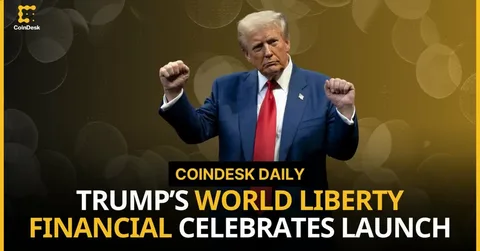Introduction
The world of cryptocurrencies has often been synonymous with high volatility, explosive growth, and sometimes, unprecedented success. In recent years, many prominent figures have launched their tokens, hoping to capture the imagination of the crypto world.
So when Donald Trump, the former president of the United States, entered the crypto space with his WLFI token sale, it seemed like a match made in marketing heaven. His brand has previously fueled various enterprises, and with a massive following, many expected the WLFI token to skyrocket.
However, things took a surprising turn. Rather than a successful and soaring venture, Donald Trump’s WLFI token sale raised just a mere 4% of its target, leaving many wondering what went wrong.
In this blog post, we will explore the potential causes behind this underwhelming performance. From marketing missteps to competition in the crowded crypto space, several factors could have contributed to the disappointing result. Let’s dive in to uncover the details.

The Initial Hype and High Expectations
When Donald Trump announced his involvement in the WLFI token sale, there was an undeniable wave of excitement. His name alone tends to draw attention, and his decision to jump into the cryptocurrency world seemed both bold and timely.
Trump has always been a controversial figure, but his ability to command attention and capitalize on his brand made the WLFI token appear as a venture with significant potential. Many believed that with Trump’s influence, the WLFI token sale would easily surpass its fundraising targets.
The initial marketing push surrounding the WLFI token sale was aggressive, aiming to tap into Trump’s massive fan base. There were high expectations, with some speculating that it could become a groundbreaking success, rivaling the meteoric rises seen by other celebrity-backed tokens. The WLFI token was framed as a unique investment opportunity tied to a high-profile figure. Trump’s supporters, crypto enthusiasts, and even curious onlookers all seemed poised to jump in.
But despite this initial hype, the WLFI token sale struggled to raise funds. The campaign’s failure to surpass more than 4% of its target raised many eyebrows. Was it simply an overestimation of demand, or were there deeper issues at play?
Market Saturation and Stiff Competition
The cryptocurrency market has evolved significantly over the past few years. What was once a relatively small community of enthusiasts and early adopters has now become a global marketplace filled with thousands of tokens. New coins and projects are launched almost daily, creating fierce competition for investor attention. In this environment, even a high-profile name like Donald Trump faces challenges.
By the time the WLFI token sale was announced, the market had already seen its fair share of celebrity-backed ventures. From musicians to actors, influencers, and athletes, many have tried their hand at launching tokens. This saturation may have diluted the impact that Donald Trump hoped to make with his WLFI token sale. Investors have become more discerning, cautious, and critical, especially with the sheer number of token offerings available.
The rise of memecoins, DeFi projects, and other blockchain innovations further complicated things. Investors are now more inclined to support projects with unique use cases or disruptive technology rather than mere celebrity endorsement. While Donald Trump remains a polarizing and influential figure, it seems that the WLFI token did not offer a distinct value proposition to stand out in the crowded crypto landscape. It became just one of many tokens, struggling to carve out its niche.
In a market overflowing with investment options, the WLFI token may have been viewed as just another speculative venture rather than a serious opportunity. Investors were already spoiled for choice, and without clear utility or advantages, Donald Trump’s WLFI token sale couldn’t cut through the noise.
Misalignment of Audience and Target Market
One of the critical issues with Donald Trump’s WLFI token sale could be a misalignment between his core audience and the typical cryptocurrency investor. While Trump has a loyal following, particularly among conservative and populist groups, it’s uncertain how many of these supporters are active participants in the cryptocurrency space.
Cryptocurrency, while gaining mainstream recognition, still attracts a certain demographic. Many active investors in the crypto world are tech-savvy millennials, Gen Z, and digital entrepreneurs who have been following the rise of blockchain technology closely. However, Donald Trump’s supporter base skews older and may not have the same level of comfort or understanding of crypto investing.
Additionally, political leanings may have played a role in the token’s poor performance. Trump’s image is divisive, and while he commands a dedicated following, he is also heavily criticized by a large portion of the population.
For those who oppose Trump, the idea of investing in his WLFI token may have been completely unappealing, if not outright repulsive. In contrast, crypto investors, who generally prefer to remain apolitical in their investment decisions, may have avoided the WLFI token sale due to its association with such a politically charged figure.
Furthermore, the messaging around the WLFI token didn’t appear to address the crypto community directly. There was no clear articulation of the token’s utility, purpose, or potential use case within the blockchain ecosystem. For seasoned crypto investors, this lack of technical detail likely raised red flags. Without a clear incentive to invest beyond Trump’s name, the WLFI token sale failed to gain traction in the crypto world.
Marketing Missteps and Lack of Transparency
Another possible factor behind Donald Trump’s WLFI token sale raising just 4% of its goal could be marketing missteps. In the world of cryptocurrency, marketing can make or break a token sale. Even well-meaning projects with innovative technology can fail if they are not marketed effectively to the right audience. In the case of Donald Trump’s WLFI token, the marketing strategy seemed to rely heavily on Trump’s brand rather than highlighting the token’s intrinsic value.
While the former president has no shortage of media coverage, the WLFI token lacked the detailed marketing campaigns that many other successful crypto projects have. There were no extensive partnerships with influencers in the crypto space, no significant presence in crypto-related media outlets, and little to no discussion about the technical aspects or roadmap of the project. Instead, much of the promotion seemed to focus on Trump’s involvement, without offering investors concrete reasons to buy in.
This lack of transparency may have also contributed to the failure of the WLFI token sale. Crypto investors are increasingly cautious and look for projects that provide detailed whitepapers, technical breakdowns, and clear development goals. Unfortunately, Donald Trump’s WLFI token sale failed to offer such information. Without these details, many potential investors may have viewed the token as a cash grab rather than a legitimate investment opportunity.
Additionally, the token sale’s low fundraising could suggest that the WLFI token lacked any substantial pre-sale hype or strategic investor onboarding. In many successful token sales, early investors and backers help drive momentum, but it seems this element was missing from the Donald Trump WLFI token campaign.
Conclusion: What Went Wrong?
In conclusion, several factors contributed to Donald Trump’s WLFI token sale raising just 4% of its target. The combination of market saturation, stiff competition, and a misalignment between Trump’s audience and the typical crypto investor proved to be significant barriers.
Additionally, the marketing strategy heavily reliant on Trump’s name, rather than the utility of the WLFI token, likely alienated more serious investors. The lack of transparency and technical details surrounding the project added to the skepticism, resulting in a token sale that didn’t resonate with its target market.
As Donald Trump and his team evaluate the WLFI token sale’s underwhelming performance, it will be crucial to learn from these missteps and potentially re-strategize. The crypto market remains a fast-paced and competitive space, where innovation and clear value propositions often trump mere celebrity involvement.
What do you think went wrong with Donald Trump’s WLFI token sale? Feel free to leave a comment below and share your thoughts!






